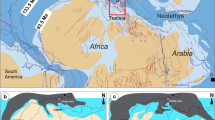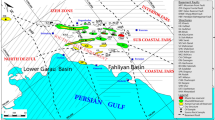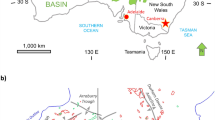Abstract
Microscopic and chemical analysis of 85 rock samples from exploratory wells and outcrops in northern Iraq indicate that limestone, black shale and marl within the Middle Jurassic Sargelu Formation contain abundant oil-prone organic matter. For example, one 7-m (23-ft.)-thick section averages 442 mg HC/g S2 and 439 °C Tmax (Rock-Eval pyrolysis analyses) and 16 wt.% TOC. The organic matter, comprised principally of brazinophyte algae, dinoflagellate cysts, spores, pollen, foraminiferal test linings and phytoclasts, was deposited in a distal, suboxic to anoxic basin and can be correlated with kerogens classified as type A and type B or, alternatively, as type II. The level of thermal maturity is within the oil window with TAI = 3− to 3+, based on microspore colour of light yellowish brown to brown. Accordingly, good hydrocarbon generation potential is predicted for this formation. Terpane and sterane biomarker distributions, as well as stable isotope values, were determined for oils and potential source rock extracts to determine valid oil-to-source rock correlations. Two subfamily carbonate oil types—one of Middle Jurassic age (Sargelu) carbonate rock and the other of Upper Jurassic/Cretaceous age—as well as a different oil family related to Triassic marls, were identified based on multivariate statistical analysis (HCA and PCA). Middle Jurassic subfamily A oils from Demir Dagh oil field correlate well with rich, marginally mature, Sargelu source rocks in well MK-2 near the city of Baiji. In contrast, subfamily B oils have a greater proportion of R28 steranes, indicating they were generated from Upper Jurassic/Lower Cretaceous carbonates such as those at Gillabat oil field north of Mansuriyah Lake. Oils from Gillabat field thus indicate a lower degree of correlation with the Sargelu source rocks than do oils from Demir Dagh field. One-dimension petroleum system models of key wells were developed using IES PetroMod Software to evaluate burial-thermal history, source-rock maturity and the timing and extent of petroleum generation; interpreted well logs served as input to the models. The oil-generation potential of sulphur-rich Sargelu source rocks was simulated using closed system type II-S kerogen kinetics. Model results indicate that throughout northern Iraq, generation and expulsion of oil from the Sargelu began and ended in the late Miocene. At present, Jurassic source rocks might have generated and expelled between 70 % and 100 % of their total oil.














Similar content being viewed by others
References
Al-Ameri TK, Al-Khafaji AJ, Zumberge J (2009) Petroleum system analysis of the Mishrif reservoir in the Ratawi, Zubair, North and South Rumaila oil fields, southern Iraq. Bahrain 14(4):91–108
Al-Ameri TK, Zumberge J, Markarian ZM (2011) Hydrocarbons in the Middle Miocene Jribe Formation, Dyala Region, NE Iraq. J Pet Geol 34(2):199–216
Al-Sharhan AS, Nairn AEM (1997) Sedimentary basins and petroleum geology of the Middle East. Elsevier, Amsterdam, 843 pages and 99 Appendix
Al-Ahmed AA (2006) Organic geochemistry, and hydrocarbon palynofacies potentris of Middle Jurassic Sargelu Formation, Northern Iraq. Unpublished Ph.D. Thesis supervised by Prof. Al-Ameri, University of Baghdad, Baghdad, 120 p
Aqrawi AAM, Goff JC, Horbury AD, Sadooni FN (2010) The petroleum geology of Iraq. Scientific Press Ltd., Beaconsfield
Batten DJ (1996a) Palynofacies and palaeoenvironmental interpretations. In: Jansonius J, McGregor DC (eds) Palynology: principles and application, 3. American Association of Stratigraphic Palynologists Foundation, Dallas, pp 1011–1064
Batten DJ (1996b) Palynofacies and petroleum potential. In: Jansonius J, McGregor DC (eds) Palynology: principle and applications, vol 3. American Association of Stratigraphic Palynologists Foundation, Dallas, pp 1065–84
Buday T (1980) The regional geology of Iraq: stratigraphy and palaeogeography. State Organization for Minerals, Baghdad, 455 p
Dunington HV (1958) Generation, migration, accumulation and dissipation of oil in Northern Iraq. In: Weeks GL (ed) Habitat of oil. The American Association of Petroleum Geologists, Tulsa, pp 1194–1251
Durand B (1983) Present trend in organic geochemistry in research on migration of hydrocarbons. In: Bjory M, Albrecht C, Corning C (eds) Advances in organic geochemistry. Wiley, Chichester, pp 117–128
Espetalie J, Laporte JL, Madec M, Marquis F, Leplat P, Paulet J (1977) Methode rapide de caracterisation des roches, de leur potentiel petrolier et de leur degre d’evolution. Rev. Inst., France, pp. 755–784, Part III, vol. 41, no. 1, pp. 75–89
Hunt JM (1996) Petroleum geochemistry and geology. W.H. Freeman and Company, New York, 743 p
Lewan MD, Ruble TE (2002) Comparison of petroleum generation kinetics by isothermal hydrous and nonisothermal open-system pyrolysis. Org Geochem 33:1457–1475
Peters KE, Walters CC, Moldowan JM (2005) The biomarker guide. Cambridge University Press, Cambridge, 2 Volumes, 1155 p
Pitman JK, Steinshouer D, Lewan MD (2004) Petroleum generation and migration in the Mesopotamian Basin and Zagros Fold Belt of Iraq: results from a basin-modeling study. GeoArabia 9(4):41–72
Pollastro RM, Karshbaum AS, Viger RG (1999) Map showing geology, oil and gas fields, and geologic provinces of the Arabian Peninsula. US Geological Survey, Open File Report 97-470B, Version 2
Rahman M, Kinghorn RRF (1995) A practical classification of kerogen related to hydrocarbon generations. J Pet Geol 18:91–102
Sharland PR, Archer R, Cassey DM, Davies RB, Hall SH, Heward AP, Horbery AD, Simmons MD (2001) Arabian plate sequence stratigraphy. Gulf PetroLink, Bahrain, 371 p
Sofer Z (1984) Stable carbon isotope compostions of crude oils: application to source depositional environments and petroleum alteration. Am Assoc Pet Geol Bull 68:31–49
Staplin FL (1969) Sedimentary organic matter, organic metamorphism, and oil and gas occurrences. Bull Can Pet Geol 17:47–66
Sweeney JJ, Burnham AK (1990) Evaluation of a simple model of vitrinite reflectance based on chemical kinetics. J Geophys Res 74(10):1559–1570
Thompson CL, Dembicki HJ (1986) Optical characteristic of amorphous kerogen and the hydrocarbon generation potential of source rocks. Int J Coal Geol 6:229–249
Tissot BP, Welte DH (1984) Petroleum formation and occurrences, 2nd edn. Springer, Berlin, XXI + 699 p
Tyson RV (1995) Sedimentary organic matters, organic facies and palynofacies. Chapman & Hall, London, Xviii + 615 p
van Bellen RC, Van Dunnington HV, Wetzel R, Morton DM (1959) Lexique stratigraphquie international, vol. III. Asie, Fasicule 10a Iraq, Centre National de la Recherche Scientifique, 333 p
Zumberge JE, Russell JA, Reid SA (2005) Charging of Elk Hills reservoirs as determined by oil geochemistry. Am Assoc Pet Geol Bull 89:1347–1371
Acknowledgments
Palynological slide preparations are performed in the Department of Geology of the University of Baghdad, while crude oil analysis and pyrolysis are performed in Geomark Research Ltd. in Houston, Texas, USA, to both we give our sincere acknowledgements.
Author information
Authors and Affiliations
Corresponding author
Rights and permissions
About this article
Cite this article
Al-Ameri, T.K., Najaf, A.A., Al-Khafaji, A.S. et al. Hydrocarbon potential of the Sargelu Formation, North Iraq. Arab J Geosci 7, 987–1000 (2014). https://doi.org/10.1007/s12517-013-0875-8
Received:
Accepted:
Published:
Issue Date:
DOI: https://doi.org/10.1007/s12517-013-0875-8




